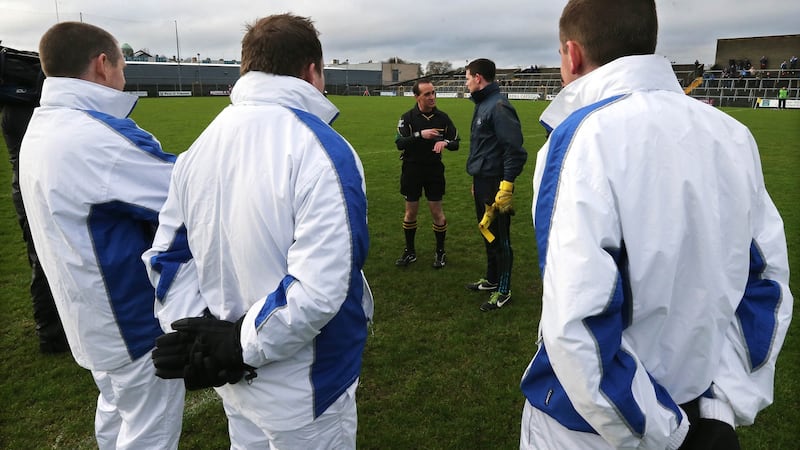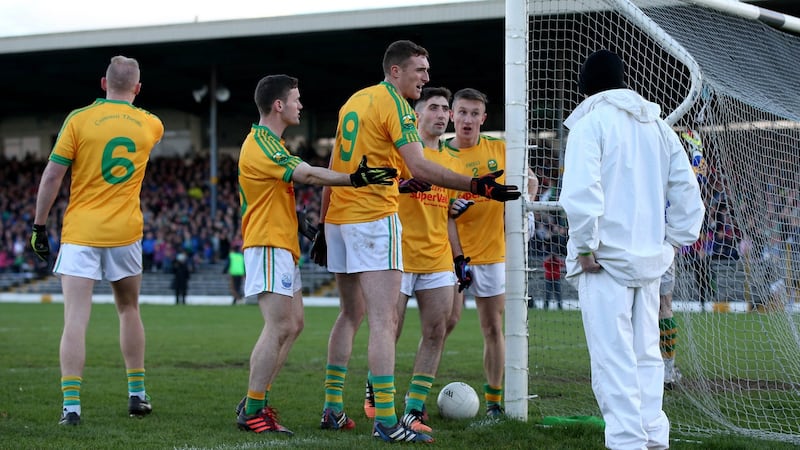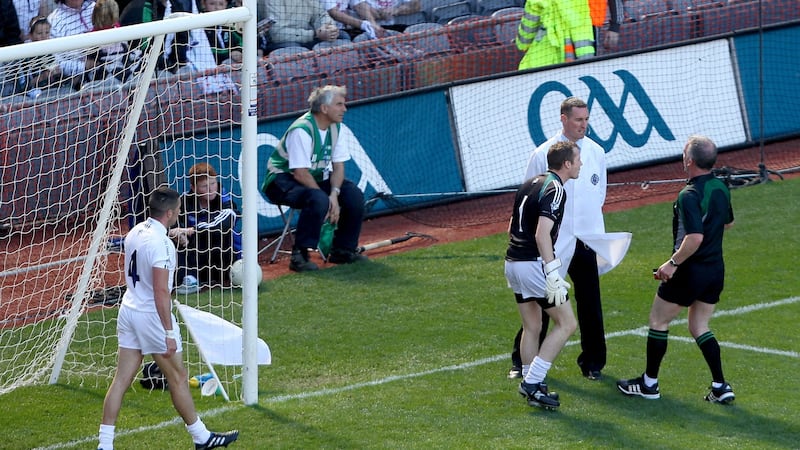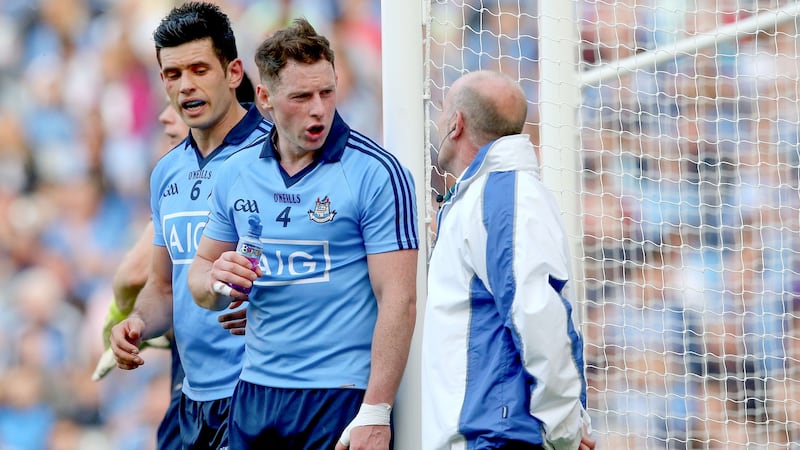Some men are born umpires. Others have umpiring thrust upon them. Mark Gilsenan was sitting at home in Corduff, Co Monaghan on a Friday night in July 2005 when his phone went and Pat McEnaney's number came up on the screen.
“What are you at on Sunday?” asked the country’s best known referee.
“Heading to Croke Park,” said Gilsenan, meaning that year’s Ulster final, which had been transplanted to HQ due to outlandish demand.

“Dead right you are,” said McEnaney. “Be at my house at 11 o’clock Sunday morning. You’re doing umpire.”
Gilsenan was 24-years-old and friendly with McEnaney’s son, Gary. About six months previously, he and Gary had gone along to a Sigerson game in Dundalk that a friend of theirs was playing in, hitching a ride with the ref along the way.
When they got to the ground, McEnaney dragooned them into standing a post apiece. That was the extent of Gilsenan’s umpiring experience before he stood in front of 61,000 patrons on a baking Croker Sunday.
“That was the long and the short of it,” Gilsenan says.
“I had never given umpiring a second thought after that night in Dundalk. I had been to Croke Park before, obviously, but the only time I was ever down on the pitch was when Monaghan won a Division Three league final earlier that year against Meath and we invaded the pitch. That’s the only time I ever stood on the field until Pat took me out at half-time in the minor match that Sunday.

“He spent about three minutes showing me behind the goals and all that. That’s the first thing you look for any time you’re at a new pitch – what sort of room is there behind the goals. The more room, the better your positioning is going to be. But that was the long and the short of it, three minutes of a look around and then do your first ever intercounty game in front of a packed house. So it was fairly nerve-wracking.”
These days, Gilsenan is a gun for hire. He does most of his umpiring with Martin McNally, an up-and-comer from his local club who is on the linesman panel for the 2017 championship. But on any given weekend, you could see him next to a post for one of any number of referees.
Last weekend, he was in Aughrim for Barry Cassidy. Earlier this year, he did a game for Maurice Deegan. David Gough, Joe McQuillan, Marty Duffy. Have white coat, will travel.
Shirt and tie
Since you ask, they get a new white coat issued by Croke Park every couple of years. Some referees like to hang on to all four coats and take responsibility for washing them (or not). Others pass them on to their chosen quartet at the start of a year and leave them at it. On any given day, an umpire’s kitbag will contain one coat, one hat, one pair of gloves, one pair of waterproof trousers. An umpire will wear a shirt and tie.
This year’s coat is lighter than previous iterations. And it must be worn. Even in the deathless heatwave of last weekend, a pre-championship edict stipulating that all umpires wear the white coat was in place. It was expected that some cries for mercy would come up at the championship umpires’ seminars in Croke Park last Tuesday and Wednesday night. But that wasn’t much good to them seven days ago.
“In Aughrim last Saturday, it was 27 degrees,” says Gilsenan. “And we still had to wear the coat over the shirt and tie. For the last couple of years when it was hot, you were okay just wearing the shirt and tie. But this year the coats have to be worn. On a 27-degree day, I knew all about it by the end of the game. It was unbelievable heat.”
To be a GAA umpire is to live in a strange sort of half-light. They are faceless and nameless and absolutely vital. Everybody sees them but nobody knows who they are. They are the closest people to the action, yet they see almost none of the game. They travel the length and breadth of the country but don’t see a cent of mileage. They get fed and that does them.
"The only thing about them is they love the grub," laughs Brian Gavin, the Offaly hurling referee. "I'm out of pocket feeding the f**kers. Refereeing for 50 cent a mile and then feeding these four big hungry fellas is not easy."
Gavin’s four horsemen are his brother, his father and two other members of his club. They’ve been with him since he started 15 years ago. Like all referees, he has assembled an extended panel to pick from, with another four lads who can come in if he’s stuck.

“The first thing when you go to intercounty level is you need a good team with you,” Gavin says. “You need fellas you can trust. That’s the most important thing. I was lucky, the four lads I got early, they’re all fairly good at it and they understand the game. A bond builds between yourself and umpires. A trust. When you’re going to matches and coming home from matches, you bounce ideas off them.
“We have signs, signals and codes going on that people at the match wouldn’t know about. Different protocols. Like, we’d have a signal for a square ball that no one else would know but I would cop it immediately. Or if there’s a deflection for a 65 and the umpire might not be sure, I will have my hand half-raised so that he knows that I’ve seen the deflection. If I keep my hands down, he waves it wide.
“For a square ball, nine times out of 10 I will be close enough to see it but if I’m not sure, my umpires just put out a finger to the side, basically pointing at the square. So straight away, I know it’s a square ball and there’s no big row about it. You get all that through years of getting used to each other.”

Everybody passed
The pitfalls and dangers zones are endless. In mid-summer, the sun coming in over the roof of the Canal End is a laser beam pointed right at the posts in front of Hill 16. If it crosses your eyeline as you’re following the ball, there’s every chance you’ll lose your bearings. Same with the lights in Parnell Park, the brightest in the country.
Some grounds are umpire-friendly, plenty aren’t. Breffni Park in Cavan has enough space behind the goals to build a small bungalow for yourself if you could get the planning through. Cusack Park in Mullingar just about has the space for the nets and nothing more.
Compulsory umpire training came in ahead of the 2011 season. Before then, it had been ad-hoc and not taken overly seriously – if it went on at all. Provinces would gather groups of lads in hotel function rooms and give them a slide show, then split them into groups and get them to fill out exam papers on what they’d seen. But they never had to do the tests individually and so everybody passed and everyone was pronounced an umpire.
Nowadays, it’s different. Croke Park is constantly updating and refining its umpire course and the ones attached to the championship panel of referees come to headquarters twice a year for refresher seminars. They’re given instructions on positioning and signalling, rule changes and their scope for involvement.
An umpire can’t award a free-kick or a penalty. An umpire can call a square ball but not a foul. An umpire can tell a referee what he has seen in terms of an off-the-ball incident but he can’t suggest a card. If you see a corner-back booked for an off-the-ball tussle do-si-do with a corner forward, that’s not the umpire’s doing. All he did was tell the ref what he saw, not what to do about it.
(Same goes for linesmen, by the by. Next time you hear them say on TV that the ref didn’t see it and the linesman told him to give a red card, know that you’re being led astray. Linesmen and umpires have the same decision-making clearance when it comes to cards, which is to say absolutely none.)

Occasionally, even the referees forget themselves. When Donegal's Eamonn McGee stamped on Enda Varley of Mayo in the 2013 All-Ireland quarter-final, Joe McQuillan found out about it over the radio from linesman Maurice Deegan.
Deegan: “Joe. A stamp by Donegal number four on Mayo number 21.”
McQuillan: “Okay. So, a red card, yes?”
Deegan: “Repeat. Number four Donegal stamped on number 21 Mayo.”
The linesman couldn’t say what course of action to take. The decision is always the referee’s.)
Square ball
Every once in a while, they make a balls of things. As humans do. Gilsenan was standing at the Canal End goal in the 2010 All-Ireland semi-final between Down and Kildare when a high ball came in and Benny Coulter got a hand to it and flicked it to the net. The Kildare defence screamed for a square ball. McEnaney came in and asked Gilsenan and the other umpire Jimmy Finnegan what they thought. They thought goal. They thought wrong.

“It still haunts us to this day,” Gilsenan says. “We got it wrong. Pat came in to consult us. As a team we got it wrong. When you see it back that night, it’s very obvious it was a square ball. Thankfully they’ve changed the square ball rule since and I don’t think there have been any real incidents of note. Nothing major anyway. But that was a bad one.
“Pat came in to consult and asked us did we think it was a square ball. And we both said no, he was fine. Pat gave the goal and went out back out the field for the kick-out and sure then it came up on the big screen. Clear as day. We knew then we had made a mistake. We took it bad, now. It hung over us for long time afterwards.”

The advent of Hawkeye has been the biggest change to their lives. In quiet moments, every umpire dreams of a GAA where all grounds are wired up for Hawkeye, where there’s no abuse from the crowd, no doubt in anyone’s mind about whether a ball went inside or outside a post. Or at least most of them do.
“If there’s any hesitation,” says Gavin, “I’ll always say, ‘Go straight to Hawkeye.’ But sure you always have lads who think they know it all and you’d come across umpires who’d be big-headed about it and decide he was making the decision himself, no matter what.
“If he makes his decision and he’s wrong, Hawkeye intervenes and then that looks bad for everybody. We have a saying in Croke Park, ‘It’s better for you to call Hawkeye than for Hawkeye to call you.’ Because when Hawkeye calls you, there’s after being a mistake. So that’s why it’s vital for even the pig-headed umpires to use it and not be embarrassed about going to it.”
Mostly though, they have to survive on their own merits, their own wit and instinct. They are invisible until they’re not and when they’re not, there’s always someone to let them know about it.
Gilsenan tells a story from a McKenna Cup match between Tyrone and Derry in Omagh one year. First week of January, lashings of rain. A few hundred hardy souls huddled in the stand and one bawling yahoo behind the goals. There’s always one.
“He was standing right in the middle of the goals and the ball came in on an angle from a shot by one of the Derry lads. The ball was about two feet inside the posts and I gave the point. Well your man just started abusing me. And he went on and on with it, wouldn’t let it go. Calling me every name under the sun, bad language, the whole lot.

“When the ball was down the other end of the pitch, I looked around at him. And he had two young children standing beside him, soaked to the bone. Can you imagine, like? I just turned back and shook my head.
"What I didn't know was the Tyrone corner-back, Dermot Carlin had heard all this. He turned around to your man and told him to shut the f**k up. He knew it was his own supporter but he didn't care. I'd say your man was wrecking his head as much as mine. It shut him up, anyway. He never opened his mouth for the rest of the game."
And Mark Gilsenan got on with his game, minding his quarter of the pitch, the rain dripping off his coat and hat and the cold invading his bones.
Loving every minute, the madman.









